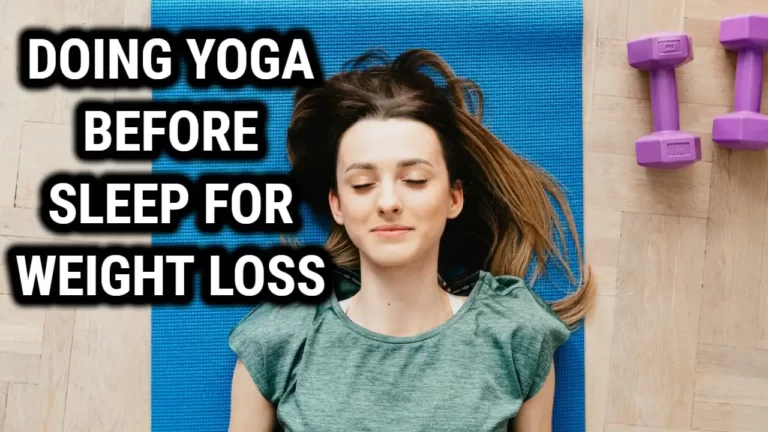The Power of 10 Minute Yoga for Weight Loss: How Yoga Can Support Your Goals

Incorporating physical activity into a weight loss plan is an important part of achieving healthy and sustainable results. However, for many individuals, finding the time and energy for a lengthy workout can be a challenge.
Fortunately, a regular 10 minute yoga practice can provide many of the same benefits as a longer workout, and can be a convenient and effective tool for weight loss.
In this article, we will discuss the benefits of 10 minute yoga for weight loss, how to get started with a 10 minute routine, and the benefits of a regular practice. We will also provide a sample 10 minute yoga routine for weight loss
How To Get Started With A 10 Minute Yoga Routine
Getting started with a 10 minute yoga routine is a simple and convenient way to incorporate physical activity into a weight loss plan. It is important to approach this practice with proper form and technique in order to maximize its benefits and avoid potential injuries.
One of the first things to consider when starting a 10 minute yoga routine is choosing the right type of yoga for your goals and fitness level. There are many different styles of yoga, each with its own unique focus and benefits.
For example, some styles, such as Hatha or Vinyasa, are more physically challenging and can help to build strength and improve cardiovascular fitness. Others, such as Yin or Restorative, are more gentle and focused on relaxation and mindfulness.
It is important to choose a style that is appropriate for your current fitness level and goals.
Another important tip for beginners is to set realistic goals and expectations. It is important to remember that yoga is a practice that takes time to master, and it may take several weeks or even months to see significant improvements in flexibility and strength. It is important to be patient and consistent in order to see results.
One of the best ways to ensure proper form and technique when starting a 10 minute yoga routine is to practice with a trained instructor or use a yoga app or video.
These resources can provide guidance and feedback on proper alignment and technique, which can help to prevent injuries and maximize the benefits of the practice.
A 10 minute yoga routine for weight loss could include the following steps:
1.Begin with a warm-up that includes some light stretching to prepare the body for the practice. This could include gentle stretches for the neck, shoulders, and hips, as well as some deep breaths to calm the mind and relax the body.
2.Move into a series of sun salutations to get the heart rate up and increase cardiovascular fitness. These could include a combination of standing poses, such as downward-facing dog and upward-facing dog, as well as flowing movements, such as lunges and warriors, to engage the core and build strength.
3.Continue with a series of standing poses, such as mountain pose, warrior I and II, and triangle pose, to engage the core and build strength in the legs and arms. These poses can also help to improve balance and stability, which can support weight loss by increasing overall physical activity levels.
4.Finish the routine with a cool-down that includes deep breathing and relaxation techniques, such as corpse pose or child’s pose, to calm the mind and allow the body to relax and release any tension.
This sample 10 minute yoga routine for weight loss can be modified for different fitness levels and preferences. For example, beginners may want to start with a shorter practice, or incorporate more rest breaks and modifications for certain poses.
More experienced practitioners may want to increase the intensity or duration of the practice, or add more challenging poses, such as arm balances or inversions.
Related Read: Best Time To Do Yoga For Weight Loss
Types of Different Yoga Poses You Can Do
1. Mountain Pose
Mountain pose is a great way to open your hips and stretch out tight muscles. It also opens up the chest, shoulders and arms so that you can breathe more easily.
The benefits of mountain pose are endless: it helps with digestion by stimulating peristalsis (the process of bowel movement), improves cardiovascular health and eases stress headaches.
To get into mountain pose:
- Sit on the floor with knees bent and feet flat on the floor, hip-width apart. Spread out your hands in front of you with palms facing up or down (use blocks if this is difficult).
- Press into each hand as though trying to lift yourself off the floor while keeping hips still; root down through heels until they meet buttocks firmly against thighs/buns without moving from side-to-side too much or letting knees go past toes (don’t let toes drag along ground).
Tip: If this is uncomfortable for you due to tightness elsewhere in body, place hands under bottom ribs instead where there’s less pressure!
2. Triangle Pose
- Breathe in and out slowly, keeping your back straight and shoulders down.
- Focus on a point in front of you, such as the tip of your nose or fingertips or any part of the floor that feels safe.
- Hold for 5 breaths.
3. Warrior II Pose
Warrior II is a great pose for beginners and advanced practitioners alike. It’s important to remember that balance is one of the cornerstones of yoga, so make sure you’re fully balanced in this pose.
To begin, lie on your back with both feet flat on the floor, knees bent and arms by your sides. Bend both elbows pointing toward each other as if you were about to bow before someone (or something) very tall (or small).
Grip opposite elbows with palms facing down slightly towards the ground—this will give you extra stability when lifting yourself up into Warrior II! Now lift your chest off the floor while keeping its base firmly planted beneath it; breathe deeply as you do so.
As soon as you feel comfortable doing so without losing any contact between torso and thighs/shins/whatever else might be supporting them (if any), lower yourself further until only one hand remains on ground beside head position.
4. Bridge Pose
Get into the pose by lying on your back, with your arms at your sides and legs together.
Bend one knee and rest it on the floor. Keep your foot flexed so that you don’t put strain on any joints in this area of the body (or overheat them). If you have trouble accessing this joint, place a block or blanket under it as support while keeping the other leg straight up off the ground.
Rock back until you feel comfortable enough to close your eyes this will help relax tension from muscles throughout your body. When ready, return to neutral position by rolling onto both sides simultaneously before standing up again.
5. Boat Pose
Lie on your back with both knees bent and feet flat on the floor, shoulders wide apart and palms facing up.
Engage your core by contracting it while pressing the tops of both feet into the ground and drawing in through the belly button (if possible).
Lift up through the navel as if you were lifting a heavy weight from below; face is toward the sky at all times during this exercise.
Hold for 5-10 breaths before lowering back down to starting position
6. High Lunge with Crescent Lunge
- Get into a low lunge with the front leg bent and back leg straight, toes pointed out.
- Hold for 5 breaths, then slowly come up to standing.
- Repeat on other side for 5 breaths before transitioning out of pose.
7. Tree Pose
Lie on your back with knees bent and feet flat on the floor.
Inhale as you curl your toes up to the ceiling, then exhale as you bring your heels down toward each other.
Hold for 2-3 breaths in this position before repeating on other side if desired. For a more challenging variation of this pose, keep both legs straight while lifting one knee off the floor (as though you were doing splits).
Inhale deeply into Tree Pose and breathe out as you slowly move into an upward fold (like a cat), inhaling through your nose as you do so; hold for up to five breaths before releasing onto all fours again practicing Knees Up The Wall pose
8. Camel Pose
How to get into the pose:
Come into a seated position, with your legs tucked under you. Bend your knees and place them on the ground in front of you, if possible.
If not, keep them straight out in front of you so that they are perpendicular to the floor (not parallel).
Bend both arms at an angle behind your back until their palms face up toward one another; then lift them over the backs of your shoulders and toward each other until both hands meet with fingers interlaced like an inverted “V” shape.
Press down firmly into this position while inhaling deeply through nose/mouth open enough for air to flow freely in and out without any resistance from throat muscles or chest wall muscles being pressed against themselves(Breathing should be slow but deep enough for good control); hold for 5 breaths before moving onto next pose.
The Benefits Of 10 Minute Yoga
A regular 10 minute yoga practice can provide a number of benefits for weight loss. In conjunction to improving flexibility and strength, as discussed in the first point, a regular yoga practice can also help to reduce stress and improve mental clarity.
This can be particularly beneficial for weight loss, as stress and mental fog can often lead to unhealthy eating habits and difficulty sticking to a weight loss plan.
By reducing stress and improving mental clarity, yoga can help to create a more positive and balanced mindset, which can support weight loss in several ways.
For example, a calmer and more focused mind can make it easier to make healthy food choices and avoid emotional eating.
A regular yoga practice can also aid in enhancing awareness, which can enhance comprehension of hunger and fullness sensations and reduce overeating.
Also Read: Doing Yoga Before Sleep For Weight Loss
Wrapping Up
A regular yoga practice can be an effective for weight loss. The combination of physical and mental benefits of yoga, increased physical activity levels, stress reduction, enhanced mental clarity, and increased flexibility and strength are just a few of the factors that can help with weight loss and well-being in general.
One of the key advantages of a 10 minute yoga routine is its convenience and accessibility. For busy individuals who may not have the time or energy for a longer practice, a 10 minute routine can be a great option. It can easily be incorporated into a daily routine, and can be done at home, at the gym, or even in a workplace or public space.
it is important to remember that consistency and patience are key to seeing results from a yoga routine.
However, with regular practice and dedication, the benefits of yoga can be truly transformative.
Regular 10-minute yoga sessions can be a useful and practical weight-loss technique.





